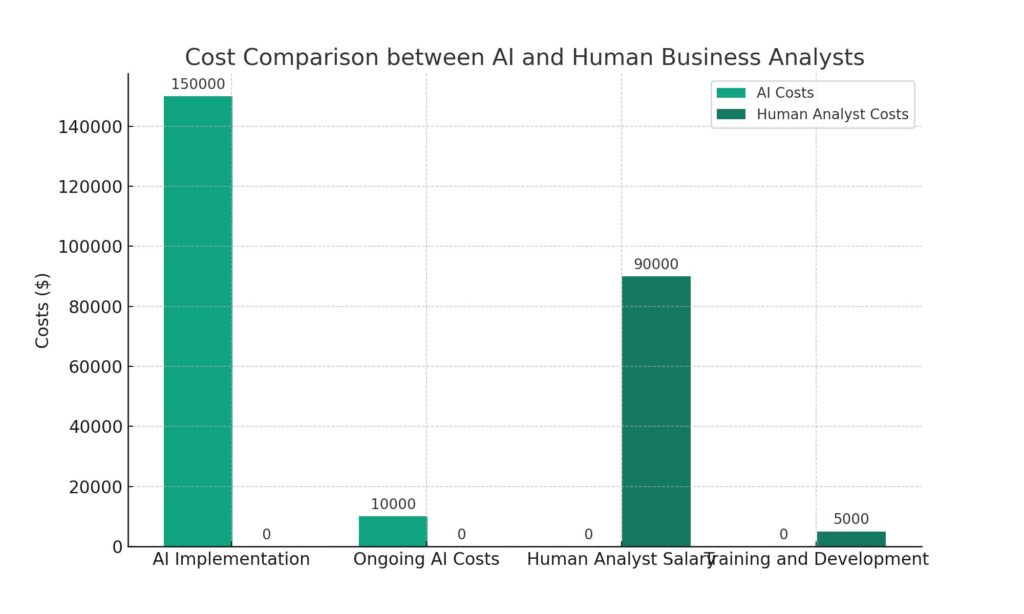Will AI Replace Human Business Analysts or Serve as a Collaborative Tool?
Conclusion: AI is unlikely to completely replace human business analysts but will serve as a powerful collaborative tool that enhances the analytical capabilities of human analysts.
Key Takeaways:
- Complementing Capabilities: AI enhances the efficiency of data processing, allowing human analysts to focus on higher-level tasks.
- Human-Centric Skills: Critical thinking, problem-solving, and creative decision-making are areas where human analysts excel and AI does not fully compete.
- Democratization of Data: AI tools like Power BI and Tableau democratize data access, empowering more users to engage with data analysis without replacing expert analysts.
- Continuous Learning and Adaptation: Human analysts are required to continually adapt and learn, integrating new AI tools into their workflows to stay relevant.

The chart titled “Cost Comparison between AI and Human Business Analysts” visually compares the different types of costs associated with AI and human analysts. It breaks down the costs into four categories:
- AI Implementation: The initial cost to implement AI systems, which is typically a significant investment.
- Ongoing AI Costs: Recurring expenses associated with maintaining and updating AI systems.
- Human Analyst Salary: The annual salary costs for employing human business analysts.
- Training and Development: Costs associated with ongoing training and professional development for human analysts.
This comparison helps businesses understand the financial implications of choosing between investing in AI systems and hiring human analysts, highlighting the initial higher costs for AI and the recurrent salary and training expenses for humans
Supporting Evidence: The evolving role of human business analysts in the age of AI highlights a shift towards more strategic and interpretive roles rather than being replaced by technology. AI excels in handling large volumes of data and performing routine tasks such as data cleaning and preliminary analysis. This automation allows human analysts to devote more time to interpreting insights, solving complex problems, and crafting compelling data stories that drive business impact (IngestAI).
Moreover, human analysts bring invaluable skills to the table, such as understanding business contexts, engaging in stakeholder communication, and applying creative solutions to unique problems. These skills ensure they remain essential to the strategic decision-making process. AI tools, while powerful, typically lack the ability to perform nuanced interpretations and make complex business decisions that require a deep understanding of the organizational and market context (Modern Analyst).
Additionally, the integration of AI in tools like Microsoft Power BI and Tableau has made analytics more accessible to non-technical users, which is often referred to as the rise of “citizen data analysts.” However, for more complex analyses and strategic decision-making, the expertise of trained analysts is indispensable (IngestAI).
As technology progresses, the partnership between human analysts and AI will likely become more integrated, making the role of the human analyst more crucial than ever. They are expected to guide AI applications within businesses, ensuring that these tools are used effectively and ethically while aligning with business objectives.
In conclusion, AI is transforming the field of business analysis by automating routine tasks and providing powerful tools for data interpretation, but it is not replacing the need for human insight and expertise. Instead, it is reshaping what it means to be a business analyst, requiring them to adapt and thrive in new ways within the AI-augmented landscape.
Here’s a comparison table analyzing the capabilities of AI and Human Business Analysts across various criteria:
| Criteria | AI Capabilities | Human Analyst Capabilities |
|---|---|---|
| Data Processing Speed | Very High – Handles large volumes rapidly | Moderate – Slower compared to AI |
| Routine Task Automation | Very High – Automates repetitive tasks efficiently | Moderate – Capable but less efficient |
| Complex Problem Solving | Moderate – Identifies patterns but lacks deep insight | Very High – Excels at interpreting complex data |
| Creative Decision Making | Low – Struggles with novel and creative tasks | Very High – Innovative and adaptable |
| Understanding Business Context | Low – Lacks understanding of nuanced business needs | Very High – Deeply understands and integrates business needs |
| Communication with Stakeholders | Very Low – Requires human mediation | Very High – Skilled in negotiation and persuasion |
| Ethical and Bias Considerations | Moderate – Can be programmed but may inherit biases | Very High – Able to consider ethical implications actively |
